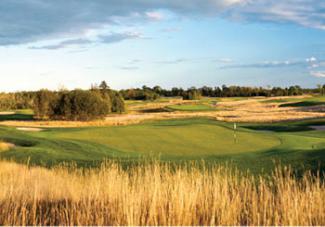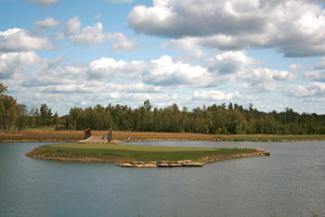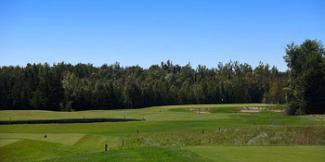Featured Golf News
Albanese Produces 'Sweet' Golf Experience in Michigan
Michigan's Upper Peninsula is full of golfing surprises, but none might be bigger than Sweetgrass Golf Club, a course that looks and feels like a links, despite its location miles from the nearest body of water. Given that the layout is also part of the Island Resort & Casino (again, the property is nowhere near water), one might reach an initial conclusion that Sweetgrass is - as we say in Texas - all hat and no cattle.

Some of the Plant Species that Define Sweetgrass GC
But after a round at Sweetgrass, golfers will find that the track - designed by Michigander Paul Albanese for the Potawatomi Tribe's Hannahville Indian Community - more than lives up to its moniker. This is a sweet place to play.
The name Sweetgrass refers to an aromatic herb and sacred plant employed in the tribe's peace and healing rituals. In its native form, sweet grass is used as one of four traditional Potawatomi medicines (along with cedar, tobacco and sage). The plant is found along the course where it serves as knee-high rough - one of the local Native American-culture references used by Albanese. Each hole at Sweetgrass is named after, and pays tribute to, Indian legend.
Albanese also had a hand in the design of TimberStone Golf Club in nearby Iron Mountain, where he worked on a completely different type of project as the lead architect for Jerry Matthews. At Sweetgrass, there were many options - the course occupies more than 300 acres - and was unbound by the rocky and rolling landscape where TimberStone was routed.

Sweetgrass GC's Island Green at No. 15
The results at Sweetgrass are an amazing contrast, and truly illustrate Albanese's prowess as a golf architect and adaptability to a specific piece of ground. "We wanted to adhere to two important goals at Sweetgrass, "Albanese said. "The golf course has to be fun and good experience for those who came out here to play it and it had to truly reflect the Native American values and principals of the Potawatomi. There is no doubt that we achieved those objectives."
Nominal earth-moving was employed on the relatively flat site and native prairie grasses were nurtured to accentuate the course's unity with nature. Albanese also rescued a half-dozen old railway bridges from the Michigan Department of Transportation to use as cart paths and to cross wetlands, giving a historic feel to the course, which opened in 2008.

Early Morning View of 12th Hole at Sweetgrass
Many Demands Here
Don't be lulled into thinking Sweetgrass is going to be easy; from the back set of five tees, the par-72 track carries a rating of 75.2 and a 143 Slope, plenty hard for even the best players.
The prairie, meadow and cedar forest on the property allowed Albanese to build strategy and shot values into every hole on the 7,275-yard layout. Golfers will find mostly expansive fairways (some 80 yards wide!) and ultra-smooth and fast putting surfaces. It's crucial to find the correct portion of a green or cope with long and tricky lag putts. Tee shots on several holes offer risk-reward opportunities, while bunkers and water hazards are strategically positioned to defend par.

First Hole at Sweetgrass Golf Club
Because of its flatness and the surrounding areas, winds can buffet Sweetgrass and add a new dimension. "Sweetgrass looks like a links course and plays like a links course, but it's obviously not a true links course," said Dave Douglas, the director of golf. "It's very playable with very generous fairways."
Douglas claims there are 47 acres of fairway turf at Sweetgrass. "On a typical golf course, there are about 28 to 30 acres of fairway, so there's almost 50 percent more fairway space here than your average course. That means you have a great chance to get a good drive out there and put yourself in a good position."
The design allows golfers to get off to a good start no matter on each side, as the first (at 320 yards) and 10th (372 yards) holes are par-4s that can be attacked.

Shared 9th & 18th Green at Sweetgrass
Elsewhere, there are three massive two-shotters: the 469-yard fourth plays from one of the highest points on the course and winds gently left to right over a ridge and past a huge bunker on the starboard side; the 489-yard 13th is a hard dogleg-left with two deep bunkers at the turn and two more right-front of the green; and the 479-yard 16th curls around a huge tree before heading uphill to the right and into the forest.
Sweetgrass has received a lot of attention for two of its par-3s. No. 12 plays 214 yards from the tips and has a 60-yard long Biarritz-style green that's a veritable rollercoaster. If the cup is cut on the back-top shelf and the tee shot is short, a three-putt (or more) is likely.
Although mid-length at 168 yards, the 15th features an island green in a lake. Both the putting surface, which jibes with the casino's name, and the turtle (the Potawatomi hold the turtle and its wisdom in high esteem) abide the course's thematic elements.
The ninth (547 yards) and 18th (550 yards) share a green, with each hole playing past a huge pond with a series of stepped waterfalls. No. 9 ascends to the landing area before heading further uphill past a huge bunker in mid-fairway to an elevated green. The closing hole is more wide open, with a series of pot-bunkers at the end of the fairway near the green.
In its first year of eligibility, Sweetgrass Golf Club was named No. 20 in Golfweek's 2009 "Best Courses You Can Play" and one of "America's Best New Courses" by Golf Digest. Since then it was listed by Golfweek as one of its "Best Casino Courses" of 2010 and by Golf Magazine as No. 13 among the "Best Courses You Can Play" in Michigan.
Sweetgrass Golf Club is in Harris, on the western side of Michigan's UP about 13 miles west of Escanaba and 40 miles east of Iron Mountain. It serves as the centerpiece of a casino-resort complex that boasts a variety of accommodations, a full-scale casino, various dining options, an indoor pool and small gym, along with meeting, event and entertainment venues.
Albanese and the Potawatomi have done their share in making his small hamlet a golf destination; now it's up to golfers to make the trek to Sweetgrass to see just how good the place really is.
For more information, see http://www.sweetgrassgolfclub.com.
Steve Habel is one of Cybergolf's world correspondents, contributing news stories, features, equipment and book reviews and personality profiles from his base in Central Texas. He is also works as a contributing editor for Horns Illustrated magazine, a publication focusing on University of Texas sports, covers the Longhorns for CBS Sports, is regional editor for Texas Golfer magazine and files stories for Golf Oklahoma magazine, Texas Links magazines and Golfers Guide. Habel's main blog (www.shotoverthegreen.blogspot.com) features news on golf and the Longhorns, and another (www.checkinginandplayingthrough.blogspot.com)chronicles his many travels, on which he has played more than 350 golf courses since 2009. Habel is a member of the Golf Writers Association of America and the Texas Golf Writers Association.
Story Options
 |
Print this Story |
